Morning Eye Candy: An Epiphytic Thing
Posted in Photography on March 6 2014, by Matt Newman
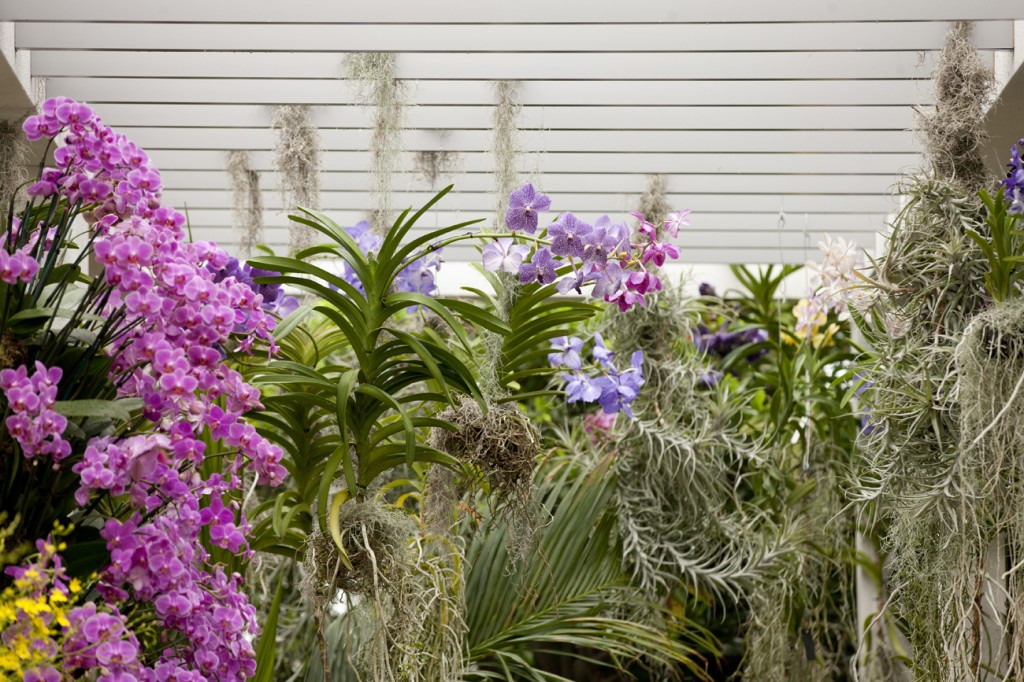
In the Enid A. Haupt Conservatory – Photo by Ivo M. Vermeulen

Inside The New York Botanical Garden
Posted in Photography on March 6 2014, by Matt Newman

In the Enid A. Haupt Conservatory – Photo by Ivo M. Vermeulen
Posted in Photography on December 20 2013, by Ann Rafalko
This showy bromeliad is also sometimes called queen’s tears. Given the colors, I must assume that the queen that shed these is one magical lady.
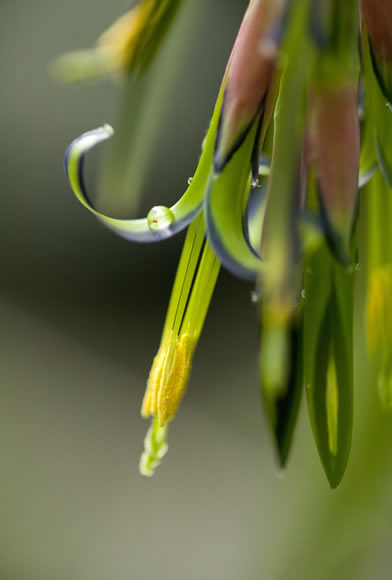
Billbergia nutans (photo by Ivo M. Vermeulen)
Posted in Gardening Tips, The Orchid Show on March 6 2012, by Sonia Uyterhoeven
Sonia Uyterhoeven is the NYBG’s Gardener for Public Education.
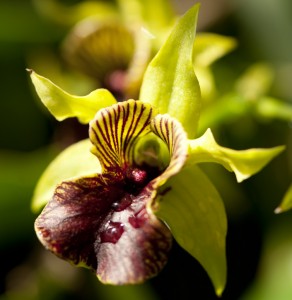 Last week we were discussing vertical gardens, or “living walls,” a specialty of French botanist Dr. Patrick Blanc. Since we are now in the midst of our spring Orchid Show, today we will explore why orchids are such good candidates for vertical gardening. With somewhere in the area of 70% of all orchids being epiphytic, members of the Orchidaceae family were destined to climb.
Last week we were discussing vertical gardens, or “living walls,” a specialty of French botanist Dr. Patrick Blanc. Since we are now in the midst of our spring Orchid Show, today we will explore why orchids are such good candidates for vertical gardening. With somewhere in the area of 70% of all orchids being epiphytic, members of the Orchidaceae family were destined to climb.
Orchids that dangle in the air–sometimes known colloquially as air plants–are classified as epiphytes. Epi- means “on top” and -phyte means “plant”–essentially growing on top of another plant. The relation the epiphyte has with the host is not parasitic (where it is harming the host), nor is it symbiotic/mutualistic (where both parties benefit), but rather commensalistic (where one benefits and the other is neutral). The term commensalism is derived from the Latin meaning “sharing a table.”
Posted in Around the Garden, Exhibitions on February 6 2012, by Joyce Newman
Joyce H. Newman is the editor of Consumer Reports’ GreenerChoices.org, and has been a Garden Tour Guide with The New York Botanical Garden for the past six years.
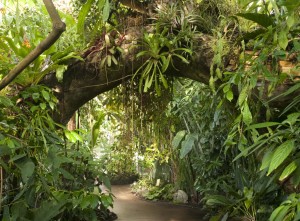 One of the most dramatic specimens in the NYBG‘s Enid A. Haupt Conservatory rainforest is the gigantic Kapok tree, now part of the Caribbean Garden exhibition. A man-made version–looking very real–arches over the lowland rainforest path, showing off numerous epiphytic plants–orchids and bromeliads–that cling to its sides. Visitors are usually amazed to learn the tree is man-made. Two other examples (one real, one man-made) in the rainforest gallery reach high atop the rainforest canopy.
One of the most dramatic specimens in the NYBG‘s Enid A. Haupt Conservatory rainforest is the gigantic Kapok tree, now part of the Caribbean Garden exhibition. A man-made version–looking very real–arches over the lowland rainforest path, showing off numerous epiphytic plants–orchids and bromeliads–that cling to its sides. Visitors are usually amazed to learn the tree is man-made. Two other examples (one real, one man-made) in the rainforest gallery reach high atop the rainforest canopy.
Posted in Around the Garden, Photography on February 1 2012, by Matt Newman
I had a habit of picking up fallen air plants while bumming around in the woods and swamps as a kid. More often than not it was a clump of Spanish moss clinging to a branch broken from a southern live oak. I would hang these covered branches all around the outside of the house, at least up until the point my dad convinced me the gray-green spirals were full of bats, snakes, and red mites (“chiggers” to a true southerner).
The jury’s still out on how many of his frantic warnings are true, but bring a tangle of the stuff to anyone south of the Virginia state line and there’s a good chance the bystander will keep his distance.
Photo by Ivo M. Vermeulen
Posted in From the Field, Paola Pedraza-Peñalosa, Science on March 10 2011, by Plant Talk
Ed. Note: NYBG Scientist and Assistant Curator, Institute of Systematic Botany, Paola, Pedraza-Peñalosa recently returned from an expedition to the Colombian Andes where she was without electricity and the Internet. Upon returning to New York, she filed these briefs about her time in the field. Follow her journey on Plant Talk.
February 4, 2011; The findings, Las Orquídeas National Park; Antioquia, Colombia
Each day had its findings. Each day came with at least one amazing plant that brought all work to a stop. That plant could be one we thought was special because of its rarity (restricted geographic distribution), or one that locals use in some interesting way; sometimes a plant could be deemed special just because it is simply too beautiful. We have selected some of our favorite plants to share them with you.
Posted in From the Field, Paola Pedraza-Peñalosa, Science on March 9 2011, by Plant Talk
Ed. Note: NYBG Scientist and Assistant Curator, Institute of Systematic Botany, Paola, Pedraza-Peñalosa recently returned from an expedition to the Colombian Andes where she was without electricity and the Internet. Upon returning to New York, she filed these briefs about her time in the field. Follow her journey on Plant Talk.
January 31, 2011; A typical day botanizing in Las Orquídeas National Park; Antioquia, Colombia
So what exactly does a botanist do in the field? In the field we look for plants that are in reproductive state, those bearing flowers or/and fruits. Reproductive structures are necessary to differentiate between closely looking species. For each species, we collect flowers, fruits, and leaves; these samples are processed and later dried for future study. The dried and mounted plant samples are called herbarium specimens and they are known to last for hundreds of years.
Posted in From the Field, Paola Pedraza-Peñalosa, Science on March 8 2011, by Plant Talk
Ed. Note: NYBG Scientist and Assistant Curator, Institute of Systematic Botany, Paola, Pedraza-Peñalosa recently returned from an expedition to the Colombian Andes where she was without electricity and the Internet. Upon returning to New York, she filed these briefs about her time in the field. Follow her journey on Plant Talk.
January 25, 2011; Arrival to Las Orquídeas National Park; Antioquia, Colombia
Las Orquídeas National Park is tucked into the westernmost mountain chain of Colombia, a part of the great Andean Cordillera. In the park the terrain is steep and rough and is crossed by many rivers and streams that originate in the upper part of the mountains. The constant presence of water makes these humid forests a source of abudant epiphytic plants. Epiphytes, like many bromeliads and orchids, are plants that grow on other plants without killing them. Epiphytes root in the humid mixture of mosses and decaying matter that cover the branches of the trees; they are a forest on top of the forest.
Posted in From the Field, Paola Pedraza-Peñalosa, Science on March 7 2011, by Plant Talk
Ed. Note: NYBG Scientist and Assistant Curator, Institute of Systematic Botany, Paola Pedraza-Peñalosa recently returned from an expedition to the Colombian Andes where she was without electricity and the Internet. Upon returning to New York, she filed these briefs about her time in the field. Follow her journey on Plant Talk.
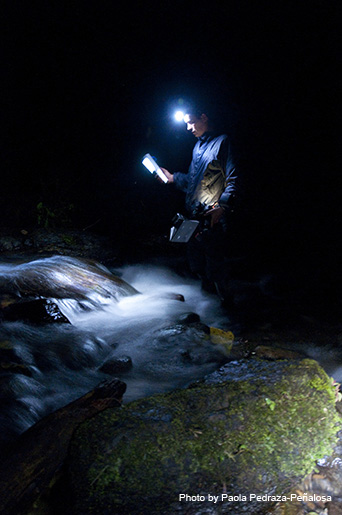
The Andes mountain chain, which crosses South America from north to south, is the longest in the world. The Andean forests of the northern range (Tropical Andes hotspot) are home to a level of plant diversity that is without match anywhere else in the world; they are also subject to high rates of deforestation, thus these forests are considered a top priority for conservation. Unfortunately, Andean forests remain insufficiently studied and protected. This lack of baseline information is often times the first impediment to effective conservation: It is impossible to efficiently protect what we do not know or understand.
To help fill these gaps, The New York Botanical Garden and the Universidad Nacional de Colombia have formed a partnership in order to inventory all the species of ferns, gymnosperms, and flowering plants of Las Orquídeas National Park, a forest reserve strategically located in the confluence of the Andean and Chocó biogeographic regions of Colombia.
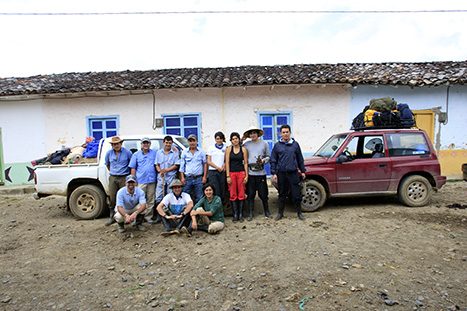
January 24 – February 4: Plant inventory at Las Orquídeas National Park; Antioquia, Colombia
After 14 days collecting plants in the field, we returned to Bogotá, Colombia’s capital with nearly 700 plant collections, and more than 10,000 photographs. Behind us we left Las Orquídeas National Park‘s 32 thousand hectares of rare and endangered tropical and montane forests, which make it part of one of the most biologically rich ecosystems of the world: the Andean and Chocó forests. We left behind more than 2,000 species of vascular plants, some of them still unknown to the science and probably not found anywhere else.
The following is an account of how we got there, what we did, and why what we found is important.